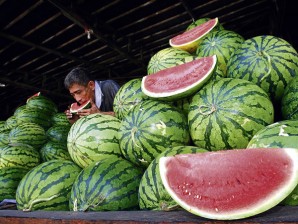
SLICE OF SUMMER A slice of watermelon is a yummy thirst quencher and entices passersby to stop and buy the fruit of summer that is selling at P120 pesos each along Edsa Monumento in Caloocan City on Tuesday. MARIANNE BERMUDEZ
Brace for even hotter days.
Summer has just begun, and the scorching heat in most parts of the country is expected to intensify towards May, weather forecasters said Tuesday.
Temperatures soared to 34.7 degrees Celsius in Dagupan City, Pangasinan, on Saturday and Sunday, so far the hottest temperature logged by the Philippine Atmospheric Geophysical and Astronomical Services Administration (Pagasa) since summer kicked in last week.
When summer peaks in May, temperatures could rise as high as 39 degrees Celsius or even 39.2 degrees Celsius, the two highest recorded temperatures in Tuguegarao, Cagayan and Cabanatuan, Nueva Ecija, respectively, on May 3 last year. Or it could rise even higher, forecaster Jori Loiz said in an interview.
“We should expect hotter weather in the coming weeks. Temperatures will rise,” he said, cautioning the public against venturing out between 10 a.m. and 3 p.m. without any protection, lest they’d get hit by ultra-violet rays.
The bureau’s station at the Science Garden in Quezon City recorded a temperature of 34.4 degrees Celsius at around 2 p.m. Tuesday.
There will be brief respites, though, in the form of afternoon or evening rainshowers, triggered by heat and moisture in the atmosphere.
“But it’s not going to rain every day,” he said.
The archipelago experiences two types of dry season: a cold dry season from December to February and a hot dry season from March to May. Summer is experienced throughout the country except for the eastern parts which are visited by rain all throughout the year.
La Niña, which has intensified the easterlies over the eastern sections of Luzon, Visayas and Mindanao, is expected to weaken soon, according to Loiz. Associated with strong rainfall, it is expected to dissipate between March and May.
Originally posted: 9:23 pm | Tuesday, March 6th, 2012